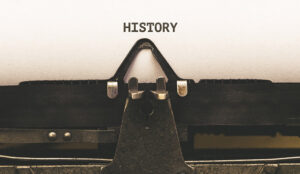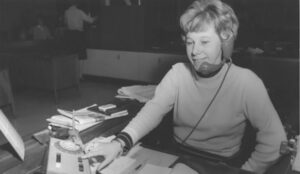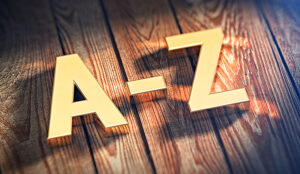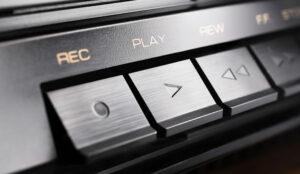Yes, folks, we’re looking for a bit of nostalgia here.
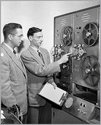
Kids today think voice recorders have always been digital, 200+ channels arrangements in 4U 19 inch racks; hah! what do they know?
Working from an article originally produced by Richard Mill of Business Systems, our team of contributors take a light-hearted look at the history of voice recorders through a series of old photographs.
Overview
The Early Days
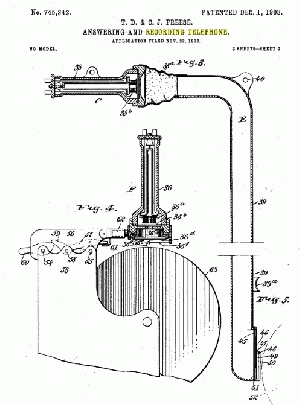
1903 Patent for a Telephone Answering Machine
It has taken a bit of time to dig back to the origins but we believe that we have found some of the earliest call recorders.
We think that this is the earliest telephone voice recorder. There may have been earlier devices which recorded Morse code from the telegraph system, but they don’t really count.
Here is a patent from 1903 of the first telephone answering and recording machine.
The patent states that “Our invention relates to telephony, our to more particular object being to provide automatic mechanism for answering calls in the absence of the operative in charge of the station and for automatically recording messages received from the line.” The patent was filed by Theodore and Carl Freese of Elria, Ohio on 22 November 1902 and was granted on 1 December 1903.
“We will describe an answering and recording telephone embodying our invention and then point out the novel features in the appended claims.”
It uses a recording on a wax disk to play a message to callers. It probably had a very limited life and never really caught on. It would wait until the invention of magnetic tape for that to happen.
View the patent of the first Answering & Call Recording Telephone
Magnetic Tape Recorders
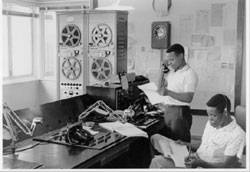
In our quest for the classic ‘early days’ of voice recording this is the best example so far.
William Hall thinks these are Philips VLS-6s (6 channels per machine) .
The best guess of usage is Air Traffic Control.
It is believed to have been installed in the Entebbe control centre.
– –
Just one glance at this photo and the nostalgia is so thick you can almost smell the mixture of salt air and diesel fumes; it makes you want to say things like, “when I was a lad, we made voice recorders out of girders”.
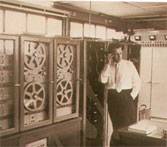
In an attempt to trace the history of these wonderful examples, we once again called on the knowledge of our oldest techie and all-round sage of the voice recording industry William Hall (15 years with BSL and prior to that wireless-man first-class in the Irish Navy).
William’s view is that this is a sea-borne type Mark 1 six-valve recorder used by submarine command; the giveaway being the small lateral mounting gimbal brackets on the side.
Our thanks to the curator of the Austrian Submariners Museum for sending this picture.
– –
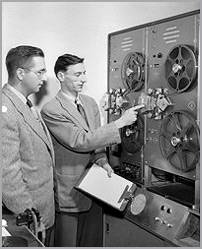
We thought this photo from Australia was an absolute gem and just begs to be published.
The note attached to it says: it’s an early recorder from the trading floor of the Oonadatta Opal Exchange – yeah right!
– –
The Australian air ambulance is a sort of low-cost flying doctor service whereas the dingo patrol uses seriously equipped Land Cruisers to monitor the outback’s 700-mile dog-proof fence, keeping it in good repair and culling dingos along the way. Being a practical bunch, the Australians combine the command and control of these two rural services because they cover the same geographical territory of about 1,500 square miles.
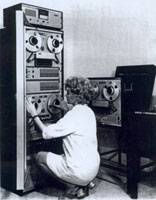
Just like air traffic controllers, the dispatchers have little room for error, as sending the wrong response unit has repercussions.
For the technically inclined the picture shows an ICR-32 with dual decks and ‘wrap capstan drives’. The large box sitting on top is known as a ‘time-code-generator’ (that’s Racal speak for ‘clock’).
Our resident ex-Racal super-tech Andy Hogan confirms this is indeed a southern hemisphere unit, the give-away being that the loaded spools run from right to left thereby working in harmony with the earth’s rotational influence which is reversed at southern latitudes.
Our thanks to the Senior Comms Officer at the ‘North Queensland Air Ambulance’ and ‘Long Range Dingo Patrol’ command centre for this picture of a Racal Recorder ICR-32.
– –
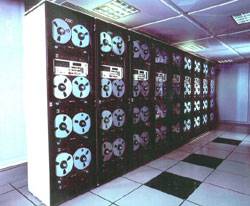
This is a picture of a call recorder at a financial institution.
The voice recording system was situated at No1 Broadgate.
Picture provided by ASC Germany – thanks guys, it’s a brilliant photo!
– –
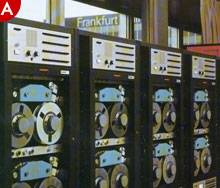
When you talk call recording today most people immediately think ‘oh yes, call centres – training purposes etc., etc.’ Well, it wasn’t always like that.
The founding father of call recording was the Air Traffic Control services.
Picture ‘A’ shows a bank of recorders which at first glance appear to be Philips VLS 44 recorders.
But on closer inspection the trained eye can determine they are the rarer VLS 33s, the give-away being the 8¼ inch spools rather than the smaller 8 inch spools as used on the 44s. Well done if you spotted that one.
– –
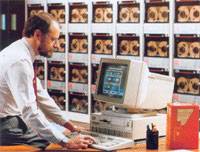
An entire team based on the number of recorders in this picture!
This is a lovely example of Racal’s ‘recorder-wall’ at Barclays’ treasury room in London. Yes, they really did stack them that high and yes, it did cause problems. The average tape-changer needed to be 6′4″ to comfortably handle the upper decks.
Although Hollywood would probably present this scene as the nerve centre of CIA monitoring operations (machines with big reels always look good in the movies), we can tell you that this stuff has not been around for decades. For the technically interested, these appear to be ICR 64s which are very rare beasts indeed. ICR 64s normally used one primary deck backed up to a standby deck, but we believe this was one of the first one to ‘n’ backup systems where there are three primaries linked to a single backup deck.
This design was a bit risqué in those days, but you got a lot more bang-for-the-buck over the standard system so financially it made good sense.
– –

Anyone who has a little bit of the philatelist in them will know that the ‘penny black’ is a rare old find and as a result is a very welcome addition to either your stamp collection or pension fund.
The recorder shown here does not fall into this class. Old and rare it may be but welcome it is not, unless of course you are desperately looking for 300 kilos of landfill.
This product was called ‘Voicelog’ and for the technically inclined, it was configured with twin decks, 101/2 inch tape spools, 24-hour run time and a whopping (at the time) 64TPI.
It was released by Callog at the height of the London banking boom in 1987 when you couldn’t buy a call recorder for love nor money. Despite the obvious ‘seller’s market’, London dealers (who are a sharp lot and know a good deal when they see one) stayed away in droves and Voicelog quietly slipped into a well-deserved obscurity.
—
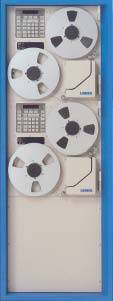
This picture was sent in courtesy of purser Mark Wright from the Navy’s supply centre at Butlers Hard on the Solent.
Mark wrote: “We considered buying one of these systems a few years ago for our command centre, but as we couldn’t find anyone else who had one we decided against it. Did we make the right decision?”
“Outstandingly good, Sir,” are the words that spring to mind; your decision is right up there along with not sailing on the SS Titanic.
The recorder in the picture was badged by Lanier (a ‘good-ol-boy’ recording company from Atlanta, Georgia) which they attempted to introduce into the UK about three years after the market here went digital. This, as you can imagine, was a bad plan and to the best of our knowledge none were ever sold.
To answer Mark’s last question –“why does the left one hang lower than the right?” It is of course an old chestnut, but in this case the reason is clear; if you mount the spools diagonally you get a narrower build, which then fits into a 19-inch rack – not a lot of people know that!
The photos were first published in the News Hound section of the Monitor Call Recording newsletter.
—
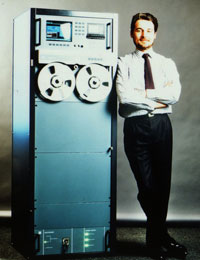
Mike Holland and an old Call Recorder Cobley 838
The final word on magnetic recorders goes to Mike Holland from Retell
“If I told you back in 1985 that you could record over 120 channels of telephone conversations on one PC you would have laughed. Then you could only record on a one-inch wide tape, the size of a dinner plate that lasted just 25.5 hours. The storage space alone for an archive of one year was equivalent to the footprint of four desks.”
Today we can store thousands of calls to DVD, data tapes and network attached storage devices. This information can be accessible ‘on line’ which makes recording a much-used and valued tool. In addition we can offer call management and statistics, screen capture, agent evaluation and marking and the ability to transmit a “your call is being recorded” message.
Not only can they see call volumes and statistics by department, team or agent but they can also identify calls on the same screen and just click to play.
Digital Recorders
Roger Keenan, who produced the first Eyretel recorder, likes to say that he invented the digital call recorder and dreamed up the idea whilst sitting on a beach somewhere in Asia. That was always a nice story for the Eyretel investors but not really accurate.
The first commercially available digital call recorder storing to hard disk was brought to market by Philips Scientific division based in Eindhoven with Racal Recorders Rapidax following about 6-9 months later.
About a year after Philips and Rapidax Roger’s Eyretel came to market with Nicelog releasing their first viable systems in 1993. Racal replaced the Rapidax with the introduction of the Wordnet Series 1 probably around 1995, and after that – well anyone with a PC and a sound card.
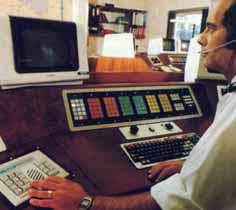
Our thanks to Craig Pumfrey of Nice Systems for this nostalgic picture of the Rapidax Ranger – the first digital call recorder released by Racal Recorders in the early 90s (91 or 92 as a best guess).
While we have high regard for Racal Recorders, there is no denying the fact that the company (up to its ears in VHS tape and Wordsafes at the time) was just a tad too traditional and the release of the Ranger was definitely on the risqué side.
There is not much to see in the photo because the processing box is out of sight but you really have to admire the switch and lamp array, it could almost be a set piece from the 60’s TV show Lost in Space.
So what happened to the Ranger?
Well, operationally it was a great success, proving beyond doubt that digital technology was the way forward, but tradition triumphed over technology and an updated version of the old analogue Wordsafe called Maxima won the day at Racal.
– –
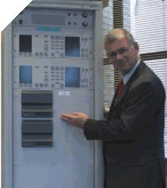
We’re looking for the real stuff; 7 foot high, 2 foot wide and 2 foot deep; weighing in at 400 kilos, a solid mass of cast iron, pulsing relays and open spool tape, all of which produced a heart-stopping 40 channels of recording over a 24-hour period; this was technology as nature originally intended!
Where are those ICR-40s, VLS-33s and Atis 200s?
Just take a look at this 19-year-old Phillips voice logger!
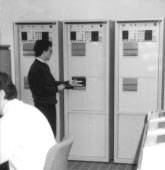
And here’s 20 years of nostalgia for Svenska Handelsbanken back in the days when they were just called Svenska Bank.
The recorders (yes it is that entire wall of metal) are Philips CLS 8000s and state-of-the-art they were too at the time.
The picture shows the old comms room at 107 Newgate Street with a youthful Paul Fincham.
Our thanks to Paul Fincham for helping us track down this photo.
Call Recording Today
Call recording in the cloud
So if that was a look at the past, what does call recording look like today?
Well in Year 2010, all recording is done digitally. The hot topics of the moment are
- call recording in the cloud (Hosted Call Recording)
- storing credit card numbers (PCI DSS and Call Recording)
- recording mobile phones (Recording Mobile Phones)
- Speech Analytics
Unfortunately, with hosted call recording you can’t really stand next to a rack of equipment. That, I’m afraid to say, is also being relegated to the history books (history eBooks, that is!).
Contributors
- Richard Mill of Business Systems
- Jonty Pearce of Call Centre Helper
- Mike Holland of Retell
Author: Jonty Pearce
Published On: 14th Mar 2010 - Last modified: 18th Aug 2025
Read more about - Technology, Call Recording, History





